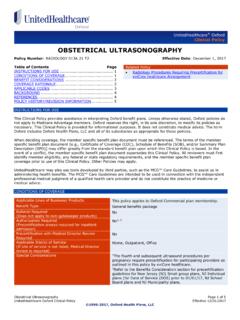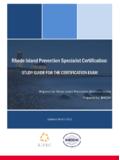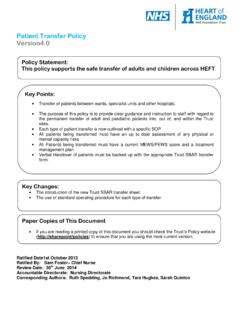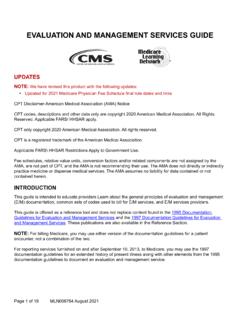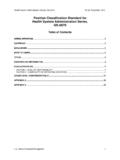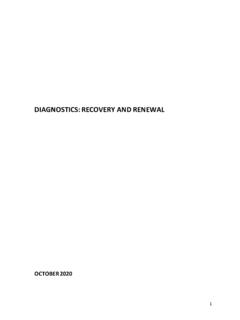Transcription of Assessment and treatment of children ... - Queensland Health
1 Document Number: QH-GDL-961:2020 Assessment and treatment of children and adolescents with eating disorders in Queensland 1. Purpose and scope The aim of this guideline is to assist staff within Queensland Health Child and Youth Mental Health services (CYMHS), Departments of Emergency Medicine, inpatient mental Health units and paediatric medical wards when assessing a child or adolescent with a possible eating disorder, and deciding the most appropriate placement, treatment and care for the child or adolescent where admission to hospital is required. This decision is based on a number of safety issues and will need to be made on a case by case basis.
2 This guideline is not designed to be a prescriptive model of care, as no single model would cater for the heterogeneity of presentations seen throughout the state. The guideline provides suggested principles and minimum standards to enhance safe service delivery and assist practitioners in their decision making. It is recommended that this guideline is used to support the formulation of local protocols and work instructions regarding clinical admission options, management of medical risks, governance issues and communication pathways. It is recognised that there are variations in local resources, and each case should be assessed on an individual basis depending on risk.
3 This guideline is designed to be used in conjunction with information and advice from: relevant local services , for example CYMHS, consultation-liaison psychiatry (C/L), dietetic services the child/adolescent and their family and/or carers the referring service. If required, specialist advice and support can be sought from: CYMHS Eating Disorders Program Telephone: (07) 3397 9077 (Monday-Friday 8:30am-5:00pm) Email: Street address: 34 Curd St, Greenslopes, Brisbane, Queensland 4120 2. Background Eating disorders are associated with significant psychiatric and medical morbidity. Appropriate treatment and care of affected children /adolescents requires close collaboration between clinicians working in psychiatric and medical settings.
4 The overarching principle guiding the treatment of children /adolescents with eating disorders within Queensland Health (QH) is that children /adolescents have access to the level of Health service they require as determined by their medical and mental Health needs. In practical terms this means that children /adolescents have a right to access medical and mental Health services across the continuum of care, including inpatient, outpatient and specialist services . This guideline specifically addresses Assessment for an eating disorder, and those circumstances where a child or adolescent with an eating disorder, or a suspected eating disorder, requires admission to hospital.
5 Queensland Health Guideline - 2 - 3. Related documents Standards, procedures, guidelines National Safety and Quality Health Service Standards, second edition, 2017 National Standards for Mental Health services , 2010 National Practice Standards for the Mental Health Workforce, 2013 (particularly standard 8: Transitions in Care) Mental Health Act 2016 (Qld) Human Rights Act 2019 (Qld) Hospital and Health Boards Act 2011 (Qld) Chief Psychiatrist Policies under the Mental Health Act 2016 Less Restrictive Way Guidelines. Queensland Health , 2019 Guideline: Admission of children and adolescents to Queensland Health acute mental Health inpatient units.
6 Queensland Health (pending publication, 2020) A guide to admission and inpatient treatment for people with eating disorders in Queensland . Metro North Hospital and Health Service, 2018 Eating disorders: a guide for community clinicians. Metro North Hospital and Health Service (pending publication, 2020) Information sharing between mental Health workers, consumers, carers, family and significant others. Queensland Health , 2017 Guideline: Transition of care for young people receiving child and youth mental Health services . Queensland Health , 2019 Guideline: Nutritional management of children and adolescents with eating disorders For children aged 6-17 years presenting in the acute care setting.
7 children s Health Queensland Hospital and Health Service, 2015. Forms, templates Statewide suite of clinical documentation Mental Health Act 2016 forms. 4. Guiding principles All treatment decisions should be made in consultation with the parents/carers and the child/adolescent (with due consideration of the child/adolescent s capacity). Clear and open communication of relevant information and support should be provided for the child/adolescent and their family and/or carers. This includes psycho-education, information about admission and inpatient care, collaborative development of care plans, relapse prevention and discharge planning, and providing the child/adolescent and their family and/or carers an opportunity to give feedback.
8 Close collaboration is required between all relevant services and clinicians to optimise decision-making and implementation of treatment and care. The least restrictive, safe treatment alternative should be provided wherever possible. However, to best meet individual needs, provisions within the Mental Health Act 2016 (MHA) and other relevant legislation can be used, where the criteria within the legislation are met. The cultural and social diversity of the child/adolescent and their family and/or carers is acknowledged, and their needs are considered throughout all phases of care. treatment and care is provided with due consideration of the child/adolescent s human rights.
9 - 3 - 5. Guidelines for Assessment of a child/adolescent presenting with possible eating disorder If the presentation is the child/adolescent s first, other medical causes for malnutrition or disordered eating patterns must be excluded. History Recommended areas for exploration in a clinical interview are outlined in Table 1 below. Table 1: Clinical interview Identifying abnormal thinking about weight, body image, diet and exercise Suggested questions to help explore attitudes towards weight control: What do you think is your healthy weight? What would you like to weigh? Do you think you need to lose more weight? Are you afraid of gaining weight?
10 Are you unhappy with your body shape? Is there any part of your body that you are especially unhappy with? Do you eat in front of others? If not, when did you stop doing this and why? How frequently do you weigh yourself? How have you tried to control your weight? What type of exercises do you do? How much exercise do you do, how often, level of intensity? What sorts of foods and drinks do you avoid, and when did you start avoiding them? Do you have any ritualised eating habits? Do you prefer to eat alone? Do you count calories/fat/carbohydrates? When young people eat large amounts quickly we call this a binge. Do you ever binge on food?










